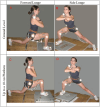My Top Five Concepts for Selecting Lower Extremity Exercises For Cruciate Ligament and Patellofemoral Rehabilitation
- PMID: 36793575
- PMCID: PMC9897005
- DOI: 10.26603/001c.65896
My Top Five Concepts for Selecting Lower Extremity Exercises For Cruciate Ligament and Patellofemoral Rehabilitation
Abstract
This clinical commentary will address five key concepts that can be used by clinicians as criteria for selecting lower extremity weight bearing exercises (WBE) and non-weight bearing exercises (NWBE) employed for cruciate ligament and patellofemoral rehabilitation. The following will be discussed for both cruciate ligament and patellofemoral rehabilitation: 1) Knee loading varies between WBE and NWBE; 2) Knee loading varies with technique variations within WBE and NWBE; 3) Knee loading varies between different WBE; 4) Knee loading varies as a function of knee angle; and 5) Knee loading increases with increased knee anterior translation beyond toes.
Keywords: cruciate rehab; knee loading; patellofemoral rehab.
Conflict of interest statement
The author of this manuscript affirm we have no financial affiliation (including research funding) or involvement with any commercial organization that has a direct financial interest in any matter included in this manuscript. The authors of this manuscript also affirm they have no conflict of interest of any kind.
Figures










Similar articles
-
Cruciate ligament loading during common knee rehabilitation exercises.Proc Inst Mech Eng H. 2012 Sep;226(9):670-80. doi: 10.1177/0954411912451839. Proc Inst Mech Eng H. 2012. PMID: 23025167 Review.
-
Anterior cruciate ligament strain and tensile forces for weight-bearing and non-weight-bearing exercises: a guide to exercise selection.J Orthop Sports Phys Ther. 2012 Mar;42(3):208-20. doi: 10.2519/jospt.2012.3768. Epub 2012 Feb 29. J Orthop Sports Phys Ther. 2012. PMID: 22387600 Review.
-
Loading response following anterior cruciate ligament reconstruction during the parallel squat exercise.Clin Biomech (Bristol). 2002 Aug;17(7):551-4. doi: 10.1016/s0268-0033(02)00063-3. Clin Biomech (Bristol). 2002. PMID: 12206949 Clinical Trial.
-
Patellofemoral Joint Loading Progression Across 35 Weightbearing Rehabilitation Exercises and Activities of Daily Living.Am J Sports Med. 2023 Jul;51(8):2110-2119. doi: 10.1177/03635465231175160. Epub 2023 Jun 5. Am J Sports Med. 2023. PMID: 37272685 Free PMC article.
-
Cruciate ligament tensile forces during the forward and side lunge.Clin Biomech (Bristol). 2010 Mar;25(3):213-21. doi: 10.1016/j.clinbiomech.2009.11.003. Epub 2009 Dec 9. Clin Biomech (Bristol). 2010. PMID: 20004502
References
-
- Biomechanics of the knee during closed kinetic chain and open kinetic chain exercises. Escamilla RAFAEL F., Fleisig GLENN S., Zheng NIGEL, Barrentine STEVEN W., Wilk KEVIN E., Andrews JAMES R. Apr;1998 Medicine & Science in Sports & Exercise. 30(4):556–569. doi: 10.1097/00005768-199804000-00014. doi: 10.1097/00005768-199804000-00014. - DOI - DOI - PubMed
-
- Effects of technique variations on knee biomechanics during the squat and leg press. Escamilla RAFAEL F., Fleisig GLENN S., Zheng NAIQUAN, LANDER JEFFERY E., BARRENTINE STEVEN W., ANDREWS JAMES R., BERGEMANN BRIAN W., MOORMAN CLAUDE T. III. Sep;2001 Medicine & Science in Sports & Exercise. 33(9):1552–1566. doi: 10.1097/00005768-200109000-00020. doi: 10.1097/00005768-200109000-00020. - DOI - DOI - PubMed
-
- Cruciate ligament loading during common knee rehabilitation exercises. Escamilla Rafael F, Macleod Toran D, Wilk Kevin E, Paulos Lonnie, Andrews James R. Jul 6;2012 Proceedings of the Institution of Mechanical Engineers, Part H: Journal of Engineering in Medicine. 226(9):670–680. doi: 10.1177/0954411912451839. doi: 10.1177/0954411912451839. - DOI - DOI - PubMed
-
- Anterior cruciate ligament strain and tensile forces for weight-bearing and non-weight-bearing exercises: a guide to exercise selection. Escamilla Rafael F., Macleod Toran D., Wilk Kevin E., Paulos Lonnie, Andrews James R. Mar;2012 Journal of Orthopaedic & Sports Physical Therapy. 42(3):208–220. doi: 10.2519/jospt.2012.3768. doi: 10.2519/jospt.2012.3768. - DOI - DOI - PubMed
LinkOut - more resources
Full Text Sources
